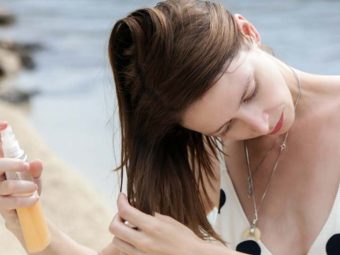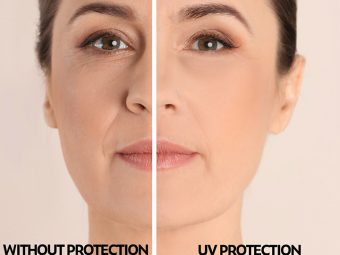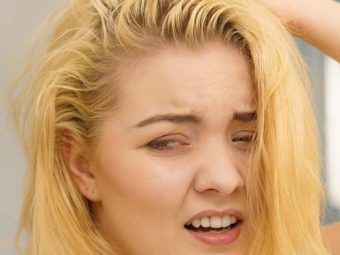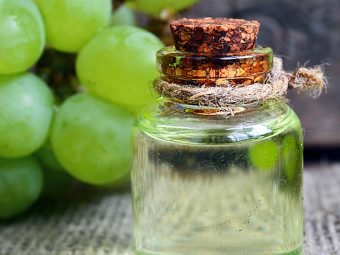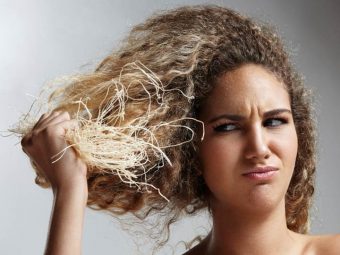16 Ways To Protect Your Hair From The Summer Sun
While protecting your hair from the summer sun can be quite a task, these tips can help.

Image: Shutterstock
We understand that the intense summer heat is detrimental to your skin, which requires appropriate precautions to keep your skin protected. However, it has a negative impact on the hair too. The heat from the sun causes weathering and oxidative damage to the hair, making it dry, brittle, and stiff (1). So, how to protect your hair from the summer sun?
In this article, we will go through the harmful effects of the sun on your hair and what you can do to protect yourself. Scroll down for more details.
 Did You Know?
Did You Know?In This Article
Effects Of The Summer Sun On Your Hair
- The UV rays can penetrate the hair cuticles, causing damage like dryness, brittleness, and weathering (1).
- The UV radiation reaches the cortex and causes pigmentation loss and protein degradation, which can cause severe hair damage (1).
- The heat from the summer sun can turn your hair lifeless and limp. This happens because of the high humidity in the atmosphere (2). This humidity may settle on your hair and weigh it down, resulting in limp hair.
- The sweat and dust contributed by summers increase hair problems like dandruff, split ends, frizziness, and increased hair fall.
- Summers can be harsh on your scalp, causing dryness and sunburn. The hair helps cover the skin (near the ear) from sun damage and may also protect the scalp from it (3). Dry scalp may end up damaging the hair roots.
- Exposure to sunlight can lead to serious hair damage, like dryness (4). Temperatures are higher in summer, and this may make your hair dryer than usual. Rough hair looks messy and detangling becomes a difficult task. You end up over-conditioning and over-treating your hair, which is a big mistake.
- During summer, you may notice your hair looking a tad lighter. This is because the UV rays affect the melanini XA natural pigment that gives color to the hair, skin, and eyes in humans and animals. in your hair (4). While dark hair might lighten just a fraction, the lighter shades of hair tend to fade more due to pheomelanin.
- Do you find your hair constantly greasy? This is because of excessive sweat and sunscreen near your hairline.
It is important to avoid overexposure to the sun and take adequate measures to protect your hair while stepping outdoors. Read on to know-how!
How To Protect Hair In Summer
While you reach out for all products that work wonders on your hair, remember to check out a few things:
- Scalp type – Oily, dry, dandruff, itchy, combination or any other medical condition.
- Hair type – Straight, curly, wavy, colored, treated, permed, straightened, or any other.
1. Avoid Too Many Cosmetics
Summers already dry your hair out and cause damage. A study shows that colored hair can show significant changes from the effects of heat (5). Hence, make sure you go easy on any chemical hair treatments during this period. Avoid too much coloring, whether at the spa or home.
If you want to color your hair or change the color during summer, try and do it a month or two before the sun hits hard. You can also try organic ingredients to color your locks.
2. Use Conditioner
While the sun is drying out your hair, make sure you help restore some moisture and life to it by using a rinse-out conditioner (6), (7). Get one that suits your hair type and texture. If you are going for a swim, remember to put on a leave-in conditioner on your hair and wear a swimming cap.
3. Shampoo With Care
While you feel like shampooing your hair every day, doing so will cause more harm than good. Too much shampoo can dry up your scalp and hair even more.
If you tend to sweat more on the scalp, and if your hair gets greasy and sweaty easily, go for a mild shampoo that is especially good for summers.
Shampoo only on the scalp, not the hair, and as you wash your hair, the suds will rinse down, cleaning up your hair too. Putting shampoo separately on your hair and hair tips will dry them out.
4. Shampoo After Swimming
A study showed that there were significant changes to hair color and protein due to the chlorine in swimming pools and UV rays from the sun (8). Using regular shampoo after swimming can help reduce hair damage from the chlorinated water.
5. Avoid Heat
Go slow on the blow dryer, and if required, wash your hair half an hour earlier so that it gets ample time to air-dry. Avoid using styling irons and curlers and let your hair be as natural as it can be.
6. Trim Your Hair
The tips of your hair take a lot of beating during the summer. This is when you see split ends and dry tips. Summer is the ideal time to give yourself a new haircut, but if you don’t want to shorten your hair, do remember to trim split ends to bring back life to your hair.
7. Care For Your Colored Hair
If you have recently colored your hair or have colored hair, you may want to take extra care of it during summer. Hair sustains maximum damage with chemical treatments, leading to color fading and excessive hair dryness.
While selecting hair care products, go for ones that are specially made for colored or treated hair. If you have recently colored your hair, go out less often in the sun, especially when it is at its peak. If you need to, cover your hair with a hat or a scarf.
 Quick Tip
Quick Tip8. Use Sun Protection
The best way to screen your hair from the scorching sun is wearing a scarf. If you don’t want to use a scarf, make sure you use a leave-in conditioner with SPF. If you have too much work outdoors and are in the sun often, opt for hair products that contain a good amount of SPF. You may also opt for a special hair mask or sunscreen product that is made for your hair type. However, make sure you wash your hair once you are home.
Sarah, a YouTuber, shares how she learned the importance of protecting hair from the sun after her hair suffered from sun damage. She says, “I started using a UV protection spray, which I would apply to my hair before heading out into the sun. I also started wearing hats more often especially when I knew I would be spending a lot of time outdoors (i).”
9. Control Frizz
The summer heat makes your hair extra dry and frizzy. Try and control your hair from becoming too frizzy by tying it up. Use the hot months to show off your hair in different styles, from braids and ponytails to updos, knots, and buns. This not only keeps your hair protected from frizz but also reduces sweating.
10. Drink Lots Of Fluids
While you may be doing all of the above to protect your hair from the sun, if you are not drinking enough water, you are not going to achieve anything. Opt for cooling liquids that will help you keep your hair healthy and hydrated. Include as many fresh fruits and vegetables in your diet as you can. This is an essential hair care tip for summer.
11. Try Co-Washing
Yes, hair gets dirtier in summers, and regular cleansing is a must. But shampooing is not the only option. Co-washing your hair, which means conditioner washing, is the ideal way to go. Wet your hair, use a replenishing conditioner for 2 minutes, and rinse off. Co-washing daily can cleanse your hair to a great extent and limits shampooing for 3-4 days.
12. Try Dry Shampoos
If you have oily hair and daily co-washing is making your hair greasy, shift to dry shampoos. You can also sprinkle some baby talc on your scalp and hair and comb it out. This is one of the simplest hair care tips for summer.
13. Go For Deep Conditioning Treatments
The hair tends to get drier, thinner, and more brittle during summer, and if you expose your hair to the sun, you need to attend to it more regularly. Deep conditioning treatments can keep your hair hydrated and nourished. But ensure you use them once a week and not every day or every alternate day. Deep conditioners contain concentrated amounts of chemicals and shouldn’t be applied on a daily basis.
14. Try New Hairdos
Try new hairstyles like ponytails, buns, and updos. They are stylish yet elegant and protect your hair from external heat damage. But if you have short hair, it doesn’t mean it can’t be just as much fun! Here are a few summer hairstyles for short hair.
15. Use The Right Hair Products
Look out for products with the tags Replenishing, Hydrating, and Moisturizing. Avoid any styling product that has formaldehyde (alcohol) and go for products containing hair- ingredients like avocado oil, coconut oil, Vitamin E, and others.
16. Night Treatment
Apply a leave-in conditioner to dry and frizzy hair, wrap a plastic cover or a towel around it, and sleep. You can also use a silk pillowcase to help with hair breakage and wake up with tamed frizz and hydrated hair.
17. Towel Gently
When you towel dry your hair, the friction can cause hair breakage. Instead of rubbing your hair harshly, try pat drying it. Scrunch up your hair in the towel and practice air drying to avoid heat damage caused by styling tools. The same goes for when you brush your hair.
Simple DIY Hair Care Masks
1. Egg And Mayo Mask To Care For Dry And Damaged Hair
Egg and mayo contain protein that is needed for healthy hair (9), (10). Eggs also contain other vitamins, minerals, and fatty acids that aid hair growth and hair health. The protein in these ingredients can help replenish hair strands.
Ingredients
- 1/4 cup plain yogurt
- 1/4 cup mayonnaise
- 1 egg white
Method
- Blend all the ingredients.
- Cover your hair with the mixture and spread it evenly by running a wide-toothed comb through your hair.
- Leave on for 30 minutes and rinse off with plain water.
2. Deep Conditioning Mask To Bring Back Moisture And Shine
Olive oil can help condition your hair and reduce hair loss and damage (11). Egg yolk nourishes your hair and can promote hair growth (12).
Ingredients
- 1 cup mayonnaise (room temperature)
- ½ cup olive oil
- 3 egg yolks
Method
- Mix everything in a bowl and apply it to your hair, especially the ends.
- Wrap your hair in a towel and leave on for about 20 minutes.
- Rinse the mask out using plain water.
Additional Home Remedies To Repair Sun Damage To Hair
3. Aloe Vera
Aloe vera can help reduce hair loss and stimulate hair growth. It protects the hair from free radical damage and UV rays. It also provides hydration and nourishment for the hair and prevents hair aging and dryness (13).
Mix some fresh aloe vera pulp with a few drops of lemon juice and apply it to your hair. Wash off after 15 minutes.
4. Banana
Bananas soften and strengthen the hair and make it manageable. They also impart shine to hair and protect its natural elasticity (14). This prevents split ends and breakage.
Mash a ripe banana into a smooth paste and add a tablespoon of honey to it. This is a simple and easy remedy for sun damaged hair.
5. Eggs
Eggs are not only healthy to eat, but they also help repair hair damage. Use egg whites for oily hair, yolks for dry hair, and the whole eggs for normal hair. Remember to wash it with lukewarm water, or you’ll end up with scrambled eggs in your hair.
6. Honey And Olive Oil
Honey and olive oil are excellent emollientsi XA substance or agent that helps moisturize the skin by forming a protective layer or barrier on the skin and trapping moisture. (15), (11). They hydrate dry hair and make it healthy.
Mix three to four tablespoons of honey with one tablespoon of olive oil. You can also add an egg yolk to this. Apply this mask to hair and wash it off after 15-20 minutes.
7. Strawberries
Strawberries contain vitamin C that promotes iron absorption and hair growth. The deficiency of vitamin C can cause split ends (10).
Mash 10 fresh strawberries and add a tablespoon of mayonnaise to make a smooth paste. Leave it on for 20 minutes. Rinse it out with water.
8. Beer
Beer contains phenolic compoundsi XA class of natural bioactive compounds found in many plant foods with anti-inflammatory properties. that have antioxidant properties (16). These antioxidants help scavenge the free radicals, thereby decreasing oxidative damage to your hair.
Rinse your hair with flat beer after shampooing to restore shine and bounce.
9. Yogurt
Yogurt nourishes your hair and repairs hair damage. This is one of the simplest home remedies to repair damaged hair. Apply yogurt on your scalp and rinse off after 15 minutes.
10. Vinegar
Dilute some vinegar in water and use this as a final rinse.
Some Facts
- Bananas and olive oil nourish the hair.
- Eggs replenish the proteins lost due to sun damage.
- Honey moisturizes hair.
- Mayonnaise acts as a natural conditioner.
- Beer and vinegar add shine and bounce.
- Strawberries and aloe vera help repair dry and damaged hair.
- Coating your hair with protective oils such as coconut oil can prevent hair from getting sun-damaged or damaged by saltwater.
Infographic: 5 Simple Remedies To Revive Sun-Damaged Hair
Constant exposure to the sun can damage your hair cuticles and increase hair fall. The good news is a few simple ingredients from your kitchen can rejuvenate, nourish, and protect the hair from further damage. Check out the infographic below for 5 easy home remedies to treat sun-damaged hair. Illustration: StyleCraze Design Team
Save the high-quality PDF version on your device now.
Download Infographic
The sun’s harmful UV rays can damage your tresses severely. It could cause hair fall, protein loss, dandruff, dryness, hair color loss, and more. But, you can protect your hair from the summer sun by making a few changes, such as not using too many products on your hair, following the right hair care practices, and avoiding heat exposure. DIY hair masks, made with natural ingredients like eggs, olive oil, banana, and aloe vera, replenish the hair and make it stronger and healthier. While you may not see immediate results, keep following these tips to see your hair flourish in the long run.
Frequently Asked Questions
Does coconut oil protect hair from the sun?
Coconut oil has a natural SPF value of 8 (17). However, that may not be enough to protect the hair and scalp from UV damage.
Can I use oil instead of sunscreen?
No. Natural oils cannot provide enough sun protection, and sunscreen is essential to safeguard your hair and skin.
Is cocoa butter better than sunscreen?
No. Though cocoa butter provides some protection from UV radiation, it cannot replace sunscreens that offer a far superior defense.
Key Takeaways
- The UV rays of the sun can destroy your locks, make it flaky, dry, stiff, and more likely to break.
- It’s best to use an SPF hair product that can shield your tresses and scalp from sun exposure.
- Plenty of water and cool fluids can keep your hair healthy, strong, and hydrated.
- Also, hot styling tools should be avoided to protect the hair from further harm.
Protect your hair this summer with sun protection, deep conditioning treatments, and avoiding harsh chemicals. Check the following video to learn more!
Personal Experience: Source
i. Protect Your Hair from Sun Damage: My Personal Story and Tips!
https://www.youtube.com/watch?v=VoHq1jY9zxE
Sources
- Sebetić, Klaudija et al. “UV damage of the hair.” Collegium antropologicum vol. 32 Suppl 2 (2008): 163-5.
https://pubmed.ncbi.nlm.nih.gov/19138021/ - Monselise, Assaf et al. “What Ages Hair?.” International journal of women’s dermatology vol. 3,1 Suppl S52-S57. 16 Feb. 2017, doi:10.1016/j.ijwd.2017.02.010
https://www.ncbi.nlm.nih.gov/pmc/articles/PMC5419032/ - Green, Adèle C et al. “Hypothesis: hair cover can protect against invasive melanoma on the head and neck (Australia).” Cancer causes & control : CCC vol. 17,10 (2006): 1263-6. doi:10.1007/s10552-006-0063-1
https://www.ncbi.nlm.nih.gov/pmc/articles/PMC1705485/ - Santos Nogueira, Ana Carolina, and Ines Joekes. “Hair color changes and protein damage caused by ultraviolet radiation.” Journal of photochemistry and photobiology. B, Biology vol. 74,2-3 (2004): 109-17. doi:10.1016/j.jphotobiol.2004.03.001
https://pubmed.ncbi.nlm.nih.gov/15157906/ - Nogueira, Ana Carolina Santos et al. “Hair color changes caused by dyeing and thermal treatments.” Journal of cosmetic science vol. 55,5 (2004): 437-47.
https://pubmed.ncbi.nlm.nih.gov/15608994/ - Gavazzoni Dias, Maria Fernanda Reis. “Hair cosmetics: an overview.” International journal of trichology vol. 7,1 (2015): 2-15. doi:10.4103/0974-7753.153450
https://www.ncbi.nlm.nih.gov/pmc/articles/PMC4387693/ - D’Souza, Paschal, and Sanjay K Rathi. “Shampoo and Conditioners: What a Dermatologist Should Know?.” Indian journal of dermatology vol. 60,3 (2015): 248-54. doi:10.4103/0019-5154.156355
https://www.ncbi.nlm.nih.gov/pmc/articles/PMC4458934/ - Pires-Oliveira, Rafael, and Inés Joekes. “Hair color damages caused by exposure to chlorinated water in the presence of ultraviolet radiation.” 26th IFSCC International Congress, Buenos Aires. 2010.
https://www.researchgate.net/publication/236109930_Hair_color_damages_caused_by_exposure_to_chlorinated_water_in_the_presence_of_ultraviolet_radiation - Réhault-Godbert, Sophie et al. “The Golden Egg: Nutritional Value, Bioactivities, and Emerging Benefits for Human Health.” Nutrients vol. 11,3 684. 22 Mar. 2019, doi:10.3390/nu11030684
https://www.ncbi.nlm.nih.gov/pmc/articles/PMC6470839/ - Goluch-Koniuszy, Zuzanna Sabina. “Nutrition of women with hair loss problem during the period of menopause.” Przeglad menopauzalny = Menopause review vol. 15,1 (2016): 56-61. doi:10.5114/pm.2016.58776
https://www.ncbi.nlm.nih.gov/pmc/articles/PMC4828511/ - Zaid, Abdel Naser et al. “Ethnopharmacological survey of home remedies used for treatment of hair and scalp and their methods of preparation in the West Bank-Palestine.” BMC complementary and alternative medicine vol. 17,1 355. 5 Jul. 2017, doi:10.1186/s12906-017-1858-1
https://www.ncbi.nlm.nih.gov/pmc/articles/PMC5499037/ - Nakamura, Toshio et al. “Naturally Occurring Hair Growth Peptide: Water-Soluble Chicken Egg Yolk Peptides Stimulate Hair Growth Through Induction of Vascular Endothelial Growth Factor Production.” Journal of medicinal food vol. 21,7 (2018): 701-708. doi:10.1089/jmf.2017.4101
https://pubmed.ncbi.nlm.nih.gov/29583066/ - García, Mario Hernández, José Adrián Trevera Juárez, and Acela Dávila Jiménez. “Importance and Properties of Aloe vera in the Production of Hair Shampoo.” The Journal of Middle East and North Africa Sciences 5 (2019): 18-23.
https://www.academia.edu/39757313/Importance_and_Properties_of_Aloe_Vera_In_the_Production_of_Hair_Shampoo - Kumar, K. P. Sampath, and Debjit Bhowmik. “Traditional and Medicinal Uses of Banana.” Journal of Pharmacognosy and Phytochemistry.
https://www.phytojournal.com/vol1Issue3/Issue_sept_2012/9.1.pdf - Burlando, Bruno, and Laura Cornara. “Honey in dermatology and skin care: a review.” Journal of cosmetic dermatology vol. 12,4 (2013): 306-13. doi:10.1111/jocd.12058
https://pubmed.ncbi.nlm.nih.gov/24305429/ - Robert Socha, Paulina Pająk, Teresa Fortuna & Krzysztof Buksa (2017) Antioxidant activity and the most abundant phenolics in commercial dark beers, International Journal of Food Properties, 20:sup1, S595-S609.
https://www.tandfonline.com/doi/pdf/10.1080/10942912.2017.1306550 - In vitro sun protection factor determination of herbal oils used in cosmetics
https://www.ncbi.nlm.nih.gov/pmc/articles/PMC3140123/













